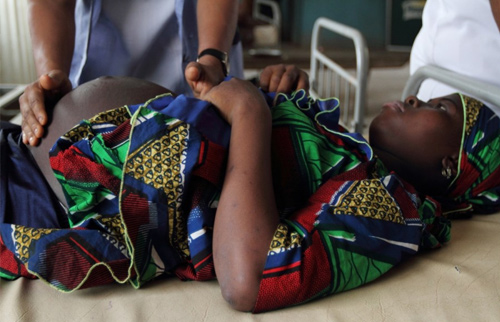Study pinpoints pregnancy complications in women with sickle cell disease
New research reports that when compared to healthy pregnant women, pregnant women with a severe form of sickle cell disease (SCD) are six times more likely to die during or following pregnancy and have an increased risk for stillbirth, high blood pressure, and preterm delivery. Research findings, published online today in Blood, the Journal of the American Society of Hematology (ASH), are the first to estimate several health risks facing pregnant women with SCD and identify those who are at highest risk of complications.
People with SCD produce abnormal hemoglobin, a protein that helps carry oxygen throughout the body. This defect causes the red blood cells to become rigid and sickle-shaped, blocking the flow of blood and oxygen to the body and causing intense pain and other complications such as infections. Previous research has identified an association between SCD and high-risk pregnancy; however, specialists have not yet been able to estimate a woman’s individual risk for specific complications, nor have they been able to identify groups of women at highest risk.
“While we know that women with sickle cell disease will have high-risk pregnancies, we have lacked the evidence that would allow us to confidently tell these patients how likely they are to experience one complication over another,” said senior study author Eugene Oteng-Ntim, MD, of the Guy’s and St. Thomas’ NHS Foundation Trust and Honorary Senior Lecturer at King’s College London. “This reality makes it difficult for us as care providers to properly counsel our sickle cell patients considering pregnancy.”
To better estimate pregnancy-related complications in women with SCD, Dr. Oteng-Ntim and a team of researchers from King’s College London and the London School of Hygiene & Tropical Medicine examined 21 published observational studies comparing outcomes in women with and without SCD.
As a whole, the studies included 26,349 pregnant women with SCD and 26,151,746 pregnant women who shared attributes with the SCD population, such as ethnicity or location, but were otherwise healthy. Investigators classified the SCD population based on genotype, or form of disease, including 1,276 women with the classic form (HbSS genotype), 279 with a milder form (HbSC genotype), and 24,794 whose disease genotype was unreported. Thirteen of the studies originated from high-income countries ($30,000 income per capita or greater), and the remaining were from low- to median-income countries.
Based on their analysis, researchers concluded that pregnant women with classic SCD living in a low-income country were at the highest risk for complications. When researchers compared these women to healthy pregnant women, they observed that women with the most severe form of SCD in both high- and low-income countries were six times more likely to die during or shortly after pregnancy. Researchers also noted that women with severe SCD had an increased risk of high blood pressure during pregnancy (known as pre-eclampsia), stillbirth, preterm delivery, and delivering smaller-than-average infants.
 While the analysis states that pregnant women with a milder or an unreported form of SCD were less likely than those with severe disease to experience complications, researchers note that these women remain at higher risk of most complications than healthy mothers. Researchers also concluded that women with SCD living in developed countries were less likely to experience death and stillbirth than those in lower-income areas. In addition, pre-eclampsia, preterm delivery, and delivery of smaller-than-average infants were not significantly different between high- and low-income countries, suggesting that risk of these conditions depends on access to care.
While the analysis states that pregnant women with a milder or an unreported form of SCD were less likely than those with severe disease to experience complications, researchers note that these women remain at higher risk of most complications than healthy mothers. Researchers also concluded that women with SCD living in developed countries were less likely to experience death and stillbirth than those in lower-income areas. In addition, pre-eclampsia, preterm delivery, and delivery of smaller-than-average infants were not significantly different between high- and low-income countries, suggesting that risk of these conditions depends on access to care.
“Our report suggests that, even in developed countries with advanced care, there continues to be a much higher maternal mortality rate in women with sickle cell disease compared to the general population, strongly suggesting that more work must be done to improve outcomes for these patients and their families,” said Dr. Oteng-Ntim. “By improving care providers’ ability to more accurately predict adverse outcomes, this analysis is a first step toward improving universal care for all who suffer from this disease.”
###
Blood , the most cited peer-reviewed publication in the field of hematology, is available weekly in print and online. Blood is the official journal of the American Society of Hematology (ASH), the world’s largest professional society concerned with the causes and treatment of blood disorders.
ASH’s mission is to further the understanding, diagnosis, treatment, and prevention of disorders affecting blood, bone marrow, and the immunologic, hemostatic, and vascular systems by promoting research, clinical care, education, training, and advocacy in hematology.
Blood® is a registered trademark of the American Society of Hematology.
###
Amanda Szabo
aszabo@hematology.org
202-552-4914
American Society of Hematology
Journal
Blood